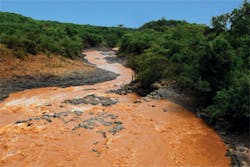Softer Approaches
Moving Back From the Beach
To avoid or at least postpone the threat of shoreline erosion to homes and other development projects, a number of coastal states now require that new structures be built back a certain distance from the shoreline. In Maine, where local officials can determine such setback requirements, 75 feet is the minimum; however, that’s not necessarily adequate in all cases. One night six years ago, for example, the top edge of a bluff shoreline moved inland about 200 feet in just a few hours, destroying two homes and leaving two others in jeopardy.
In North Carolina, the setback is measured landward from the line of stable natural vegetation nearest the sea, usually near the base of the frontal dune system. All single-family homes and buildings of 5,000 square feet or smaller, as well as their septic systems, must be located 30 times the historical, long-term erosion rate from this line with a minimum setback of 60 feet. For larger buildings, the minimum setback is 120 feet.
Rhode Island rules also require a setback equal to 30 times the annual erosion rate for residential structures. Theoretically, that would allow a homeowner 30 years before a house would be threatened. “That should be enough time to pay off the mortgage,” remarks Freedman. The setback for commercial property is 60 times the annual erosion rate. The minimum setback for both residential and commercial property is 50 feet.
Not everyone willingly accepts such regulations, notes Jon Boothroyd, Rhode Island’s state geologist and a professor at the University of Rhode Island. “Everyone wants to be more seaward than their neighbor to get the best views, so setbacks and other requirements of our coastal management plan are contested frequently. However, every time we upgrade the plan, we improve it scientifically. So it’s getting more difficult to argue against the rules based on scientific merit.”
Sometimes, retreating from the shoreline might be the least expensive option for dealing with erosion problems. “Most threatened oceanfront property owners probably don’t seriously consider this, simply because of a desire to protect their home and view at any costs. However, where structural protection is not feasible, relocating or removing oceanfront buildings, utilities, or roads may be the only options,” says Boothroyd.
Maine is one state that requires an existing structure to meet current setback requirements if the cost to repair storm-related erosion damage exceeds 50% of the structure’s value, Dickson states. If damage is less than that, homeowners can improve the structure to make it more resistant to future storms.
Lending Nature a Hand
Another alternative for dealing with eroding shorelines is to work with nature to improve the odds of long-term success. On some of the barrier islands of Louisiana, breakwaters are being built to restore beaches, and fences and trees are being installed to trap sediment. The idea is to protect the more fragile interior marsh from ocean waves. At the same time, fresh water from the Mississippi River is being diverted to the smaller rivers and bayous that lead to the marsh, just as the river did years ago before the start of dredging and levee building. In another case, rich silt dredged from the Mississippi River to maintain ocean-going ship traffic to and from New Orleans is being used to create a new marsh in a bay. Again, the goal is to replicate the river’s natural process.
Learning More About the Erosion Process
Another key to handling shoreline erosion is increasing understanding of the problem. Two years ago, Dickson organized citizen volunteers into 14 Beach Profiler teams. Once a month they fan out along about a 60-mile stretch of coastline from York to Cape Elizabeth in the southeast part of Maine to measure and photograph the beaches to gather information on erosion. Each team, consisting of three to seven people, develops four profiles within about a mile of each other. The process, which takes about two hours, supplements the work of the State Geological Survey.
“There’s no way we could afford enough state and academic labor to profile such a lengthy portion of the beach this intensely,” says Dickson. “These volunteers love their beaches and are eager to get involved in learning more about them. The information they gather helps us learn about monthly cycles of beach erosion and accretion and the impacts of specific storms on the beaches.”
The citizen teams have produced more than 2,000 beach profiles to date. Their findings are discussed at an annual conference. They are also available on the Web at www.state.me.us/doc/nrimc/mgs/marine/marine.htm.
As the search for better solutions to shoreline erosion problems continues, one things seems fairly certain: Whether it’s a property owner seeking to protect land and buildings or the public seeking to preserve its enjoyment of coastal beaches, an approach that benefits one party might not necessarily please the other.
